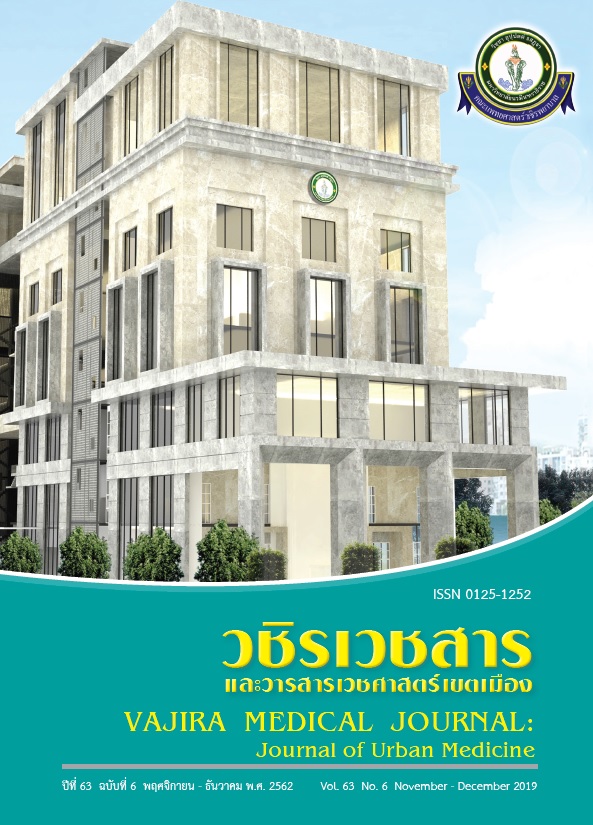The Effectiveness of Art Therapy Program on Quality of Life among Older Adults with Chronic Illness in Urban Areas:An Older Adult Club
Main Article Content
Abstract
Objective: To examine the effectiveness of art therapy program on quality of life among older adults with chronic illness in an urban area: a case study of an older adult club.
Methods: This quasi-experimental research was two groups with a pretest-posttest design. The sample consisted of 44 older adults (N=44) with chronic illness, particularly diabetes mellitus, hypertension, coronary-artery disease, stroke, and osteoarthritis who are members of an older adult club and live in Nonthaburi province and Bangkok. The participants were divided equally into a control group (n=22) and an experimental group (n=22), and they were matched-pair by age, gender, multimorbidity, and an appointment with a doctor to follow up. The experimental group received the eight weeks with the art therapy program one time per week, while the control group received routine activities. All instruments were verified for content validity by five professional experts. Data were collected using the WHOQOL-BREFTHAI, and Cronbach’s alpha coefficient of this questionnaire was .84. Data were analyzed using descriptive and t-test statistics.
Results:
1) The mean change in scores of quality of life among older adults in the experimental group after receiving the art therapy program ( = 99.25, SD = 7.74) was significantly higher than before receiving the program (
= 88.40, SD = 8.74) (p < .05).
2) The mean change in scores of quality of life among older adults in the experimental group after receiving the art therapy program ( = 99.25, SD = 7.74) was significantly higher than those who received usual leisure activities (
= 88.40, SD = 8.74) (p < .05).
Conclusion: The results of the study emphasized the art therapy program could improve quality of life among older adults with chronic illness in urban areas and was better than those who received usual leisure activities.
Downloads
Article Details
References
Institute for Population and Social Research, Mahidol University. Population of Thailand. Mahidil population 2019; 28: 1-2.
Department of Older Persons, the Ministry of Social Development and Human Security [Internet]. 2 [cited 2019 30 July]. Available from:https://www.dop.go.th/en/know/2/108
Eliopoulos C. Gerontological Nursing. 8th ed. Philadelphia: PA: Lippincott Williams & Wilkins;2014.
Ebersole, P., Hess, P., and Jett, K. Gerontorogecal Nursing Health Aging. 6th ed. St. Louis: Mosby, Inc; 2014.
Sakuntala Anuruang. Multimorbidity in Older Persons: Situation Issues, and Care Management, Challenge. Journal of Nursing Science Chulalongkorn University 2017; 29 No. (2): 1-14.
Strategy and planning division. Office of the permanent secretary. Ministry of public health [Internet]. 2 [cited 2019 30 July]. Available from:https://www.dop.go.th/en/know/2/108
Wannachart M, Nanthamongkolchai S, Munsawaengsub C, Taechaboonsermsak P. Quality of Life among Elderly People with Chronic Diseases in Ubon Ratchathani Province Journal of Public Health Special Issue 2015;21(1) : 18-29.
Chetpakdeechit N, Niputhuttapong S, Kwanyuen R, Baljay Y, Thongwachira C. Relationship between perceptions of health status, needs, expectations, ability for self-care among elderly people dwelling at Community in Khet BangPhlat in Bangkok of Thailand. KKU International Journal of Humanities and Social Sciences 2018;8(3): 123-34..
Tupanich W, Chaiyalap S, Chaiyalap K . Problems and Needs of Older Adults Living in Urban Area, Bangkok Metropolitan . Vajira medical journal:Journal of urban medicine. 2019; 63: 585-92.
Sathit Kurathong. Urban Medicine. Vajira medical journal: Journal of urban medicine 2016; 60(1): 1-4.
Kelly CG, Cudney S, Weinert C. Use of creative arts as a complementary therapy by rural women coping with chronic illness. Journal of Holistic Nursing. 2012; 30(1): 48-54.
Kim S. A randomized, controlled study of the effects of art therapy on older Korean-Americans’healthy aging. The Art in Psychotherapy. 2013;40(1): 158–64.
Svensk AC, Oster I, Thyme KE, Magnusson E, Sjodin m, Eisemann M, etal. Art therapy improves experienced quality of life among women undergoing treatment for breast cancer: a randomized controlled study. Europan Journal of Cancer Care 2009;18(1):69-77.
Kaimal G, Ray K. Free art-making in an art therapy open studio: changes in affect and selfefficacy. Arts & Health An International Journal for Research Policy and Practice. 2017; 2: 154-66.
Kanpangsri N,Kespichayawattana J. The Effect of an Art Activity Program on Self-Esteem of Older Persons with Early Stage Dementia. Rama Nurs J. 2014; 20(2): 163-8.
Weiss, J. C.. Expressive Therapy with Elders and the Disabled Touching the Heart of Life. USA:The Haworth Press, Inc. 1984.
Baljay Y,Sughondhabirom P,Kespichayawattana J. Art Therapy for Older Persons. Kuakarun Journal of Nursing. 2018; 25(2): 195-09.
Intamuen N, Suppapitiporn S. Effect of therapeutic arts in the elderly with mild to moderate depression. Chula Med J 2013 Nov - Dec; 57(6): 751 – 63.
Tests mental Health, Department of Mental Health [Internet]. 2 [cited 2019 30 July]. Available from: https://www.dmh.go.th/test/whoqol/.
Rubin, J. A.. Artful Therapy. New Jersey: John Wiley & Son, Inc. 2005.
Proulx L. Attachment Informed Art Therapy, Victoria; 2017.


